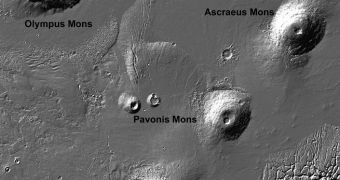A long-term study of the Martian underground, conducted using the European Space Agency's (ESA) Mars Express orbiter, has revealed the makeup of lava flows and densities underneath some of the largest volcanoes on the Red Planet.
The analysis is essential for improving our understanding of how the neighboring world's interior evolved over time and, ultimately, towards determining whether it was ever able to support lifeforms.
Mars Express focused on the Tharsis region, home to the largest volcanoes on the Red Planet. In order to study the underground, the orbiter produced a series of gravity maps covering this entire area.
Researchers learned that lava just under the surface grew denser over time, a process that made the crust above display uneven thickness throughout the Tharsis region. The gravity maps were compiled from altitudes between 275 and 330 kilometers (170 to 205 miles) above the Martian surface.
In order to improve the accuracy of these readings, ESA investigators combined information relayed back to Earth by Mars Express with datasets compiled by the NASA Mars Reconnaissance Orbiter (MRO), which has been studying the planet since 2006.
The so-called Tharsis bulge is home to three Tharsis Montes – the landscape features arranged in a row in the image to the left – and the largest volcano in the solar system, Olympus Mons, which dwarfs Mount Everest at an altitude of 21 kilometers (13 miles).
One of the most interesting things about the Tharsis region is that it was volcanically active until 250 to 100 million years ago, which is very recently in geological terms. Mars Express determined that, for the most part, all four volcanoes are made out of basalt.
“Combined with the varying height of the volcanoes, we can say that Arsia Mons is the oldest, then Pavonis Mons formed and finally Ascraeus Mons,” Royal Observatory of Belgium astronomer Mikael Beuthe explains.
He is also the lead author of a new paper detailing the findings, which is published in the latest issue of the esteemed Journal of Geophysical Research.
“The lack of a high-density root below Olympus Mons indicates it was built on a lithosphere of high rigidity, while the other volcanoes partially sank into a less rigid lithosphere,” ROB expert and study coauthor Veronique Dehant, adds.
“This tells us that there were large spatial variations in the heat flux from the mantle at the time of their formation,” she concludes.

 14 DAY TRIAL //
14 DAY TRIAL //